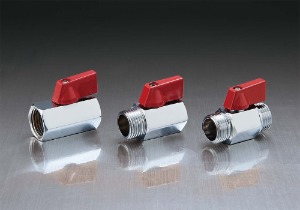2025-06-25
Welding is used in the production of brass mini ball valves to join different components together, such as the valve body, ball, and stem. The choice of welding process can have a significant impact on the final product's strength, durability, cost, and performance. In this blog, we will compare the main welding processes used in the production of brass mini ball valves, including TIG welding, MIG welding, and brazing, highlighting their advantages and drawbacks.

A brass mini ball valve typically consists of a few main components:
Body: The valve housing that contains all the internal parts.
Ball: A spherical component with a hole in the center that regulates the flow.
Stem: The part that connects the ball to the actuator (manual lever or motorized device).
Seats and seals: Ensure that the valve provides a leak-proof seal when closed.
The components of the valve are usually joined together using welding or brazing, depending on the requirements of the application and the materials involved. Let's explore the common welding processes in detail.
1. TIG Welding (Tungsten Inert Gas Welding)
TIG welding, also known as Gas Tungsten Arc Welding (GTAW), is a highly precise welding method that is often used when working with materials like brass. In this process, a tungsten electrode is used to create an arc between the electrode and the brass parts, which are melted and fused together with the help of a filler material. A shielding gas, usually argon, is used to protect the molten weld pool from contamination by atmospheric gases.
Advantages of TIG Welding for Brass Mini Ball Valves:
High Precision: TIG welding provides control over the heat input, making it ideal for welding small and delicate components like those in brass mini ball valves.
Clean Welds: Since TIG welding uses an inert shielding gas, it produces clean, high-quality welds with minimal spatter or contamination.
Strength: The process produces strong welds that are less likely to crack or break, which is critical in ensuring the integrity of fluid control systems.
Appearance: The aesthetic quality of TIG welds is often, leaving smooth and neat weld seams, which is important for maintaining the appearance of the valve.
Disadvantages of TIG Welding:
Slow Speed: TIG welding is slower compared to other welding methods, which can increase production time and costs, especially for large-scale manufacturing.
Requires Skilled Operators: The precision required for TIG welding makes it a process that demands a high level of skill and expertise, potentially increased labor costs.
Higher Equipment Cost: The equipment used for TIG welding, such as the tungsten electrodes and specialized shielding gases, can be expensive.
2. MIG Welding (Metal Inert Gas Welding)
MIG welding, or Gas Metal Arc Welding (GMAW), is another common welding process used in the fabrication of brass mini ball valves. In MIG welding, a continuously fed wire electrode is used as both the filler material and the electrode. A shielding gas (typically argon or a mixture of argon and CO2) is used to protect the weld pool from contamination. MIG welding is a faster process compared to TIG welding and is often used for larger-scale production.
Advantages of MIG Welding for Brass Mini Ball Valves:
Faster Production: MIG welding is generally faster than TIG welding, making it more suitable for high-volume production of brass mini ball valves.
Lower Skill Requirements: While MIG welding still requires skill, it is less demanding than TIG welding, making it easier to train operators and lower labor costs.
Cost-Effective: MIG welding equipment is typically less expensive than TIG welding setups, and the faster process results in lower overall production costs.
Versatility: MIG welding is highly versatile and can be used to weld a variety of materials, making it ideal for manufacturers who work with multiple metals in addition to brass.
Disadvantages of MIG Welding:
Lower Precision: MIG welding, while efficient, may not provide the same level of precision as TIG welding. This can result in less control over heat input and the potential for defects, particularly when working with small, intricate parts like the components of a brass mini ball valve.
Weld Quality: MIG welding can sometimes result in less aesthetically pleasing welds, with more spatter and a rougher finish, which might affect the appearance of the finished valve.
Limited for Thin Materials: While MIG welding is effective for thicker materials, it is less ideal for thin-walled brass components, which are often found in mini ball valves.